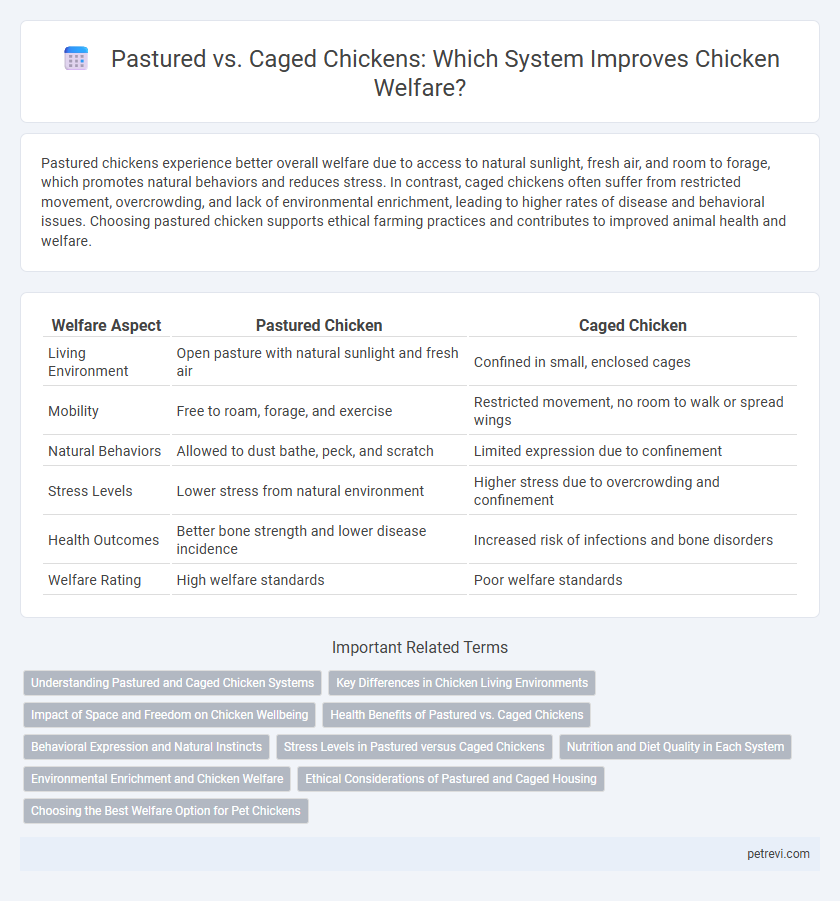Pastured chickens experience better overall welfare due to access to natural sunlight, fresh air, and room to forage, which promotes natural behaviors and reduces stress. In contrast, caged chickens often suffer from restricted movement, overcrowding, and lack of environmental enrichment, leading to higher rates of disease and behavioral issues. Choosing pastured chicken supports ethical farming practices and contributes to improved animal health and welfare.
Table of Comparison
| Welfare Aspect | Pastured Chicken | Caged Chicken |
|---|---|---|
| Living Environment | Open pasture with natural sunlight and fresh air | Confined in small, enclosed cages |
| Mobility | Free to roam, forage, and exercise | Restricted movement, no room to walk or spread wings |
| Natural Behaviors | Allowed to dust bathe, peck, and scratch | Limited expression due to confinement |
| Stress Levels | Lower stress from natural environment | Higher stress due to overcrowding and confinement |
| Health Outcomes | Better bone strength and lower disease incidence | Increased risk of infections and bone disorders |
| Welfare Rating | High welfare standards | Poor welfare standards |
Understanding Pastured and Caged Chicken Systems
Pastured chicken systems allow birds to roam freely outdoors, promoting natural behaviors and improving overall welfare through access to sunlight, fresh air, and diverse forage. Caged systems confine chickens in limited spaces, restricting movement and often leading to stress, increased disease risk, and physical ailments like foot lesions. Understanding these contrasting systems highlights the significant impact of environment on chicken health, behavior, and welfare outcomes essential for ethical poultry farming.
Key Differences in Chicken Living Environments
Pastured chickens have access to outdoor spaces, natural sunlight, fresh air, and forage, which promotes natural behaviors such as pecking, scratching, and dust bathing. Caged chickens are confined to small, enclosed spaces with limited movement, often lacking environmental enrichment and exposure to natural elements. These contrasting living environments directly impact chicken welfare, with pastured systems supporting better physical health and psychological well-being compared to conventional caged conditions.
Impact of Space and Freedom on Chicken Wellbeing
Pastured chickens experience significantly improved welfare due to increased space and freedom, promoting natural behaviors such as foraging, dust bathing, and social interactions. In contrast, caged chickens face severe restrictions, leading to stress, reduced physical health, and higher susceptibility to diseases. Access to open environments in pastured systems enhances physical fitness and psychological well-being, ultimately supporting stronger immune systems and longer lifespans.
Health Benefits of Pastured vs. Caged Chickens
Pastured chickens exhibit higher levels of omega-3 fatty acids, vitamins A and E, and lower cholesterol compared to caged chickens due to their varied diet and natural foraging behavior. The increased exposure to sunlight in pastured environments enhances vitamin D synthesis, contributing to superior bone health and immunity. Caged chickens often face limited mobility, leading to higher stress and susceptibility to diseases, which negatively impacts the nutritional quality of their meat and eggs.
Behavioral Expression and Natural Instincts
Pastured chickens exhibit enhanced behavioral expression by freely foraging, dust bathing, and engaging in natural social interactions, which align closely with their innate instincts. In contrast, caged chickens experience significant restrictions that suppress these behaviors, leading to heightened stress and frustration. Promoting pastured environments supports chickens' natural behaviors, improving overall welfare and health outcomes.
Stress Levels in Pastured versus Caged Chickens
Pastured chickens experience significantly lower stress levels compared to caged chickens due to increased space, natural sunlight, and the ability to engage in instinctive behaviors like foraging and dust bathing. Elevated cortisol levels and abnormal behaviors, such as feather pecking, are commonly observed in caged chickens because of confinement and limited mobility. Stress reduction in pastured systems enhances immune function and overall well-being, leading to healthier poultry.
Nutrition and Diet Quality in Each System
Pastured chickens benefit from a natural diet consisting of grasses, insects, and seeds, leading to higher levels of omega-3 fatty acids, vitamins A and E, and antioxidants in their meat and eggs. Caged chickens rely primarily on formulated feed, often rich in grains and soy, which can result in lower nutrient density and reduced fatty acid profiles. Studies show pastured systems enhance nutritional quality by promoting a diverse diet and improving the overall welfare of the birds.
Environmental Enrichment and Chicken Welfare
Pastured chickens benefit from extensive environmental enrichment through access to natural vegetation, fresh air, and space to exhibit natural behaviors such as foraging, dust bathing, and perching, which significantly enhance their overall welfare. In contrast, caged systems restrict movement and limit stimulation, often leading to increased stress, feather pecking, and reduced immune function. Providing enriched, spacious environments in pastured systems promotes better physical health, mental well-being, and more natural behavioral expressions in chickens.
Ethical Considerations of Pastured and Caged Housing
Pastured chicken housing promotes natural behaviors such as foraging and dust bathing, improving overall animal welfare and reducing stress-related illnesses. In contrast, caged systems restrict movement and prevent chickens from exhibiting instinctive actions, raising significant ethical concerns regarding confinement and animal suffering. Ethical considerations prioritize pastured conditions for aligning chicken welfare with humane treatment standards and enhancing quality of life.
Choosing the Best Welfare Option for Pet Chickens
Pastured chickens benefit from natural behaviors such as foraging, dust bathing, and increased exercise, which significantly enhance their overall welfare compared to caged systems. Caged chickens often suffer from restricted movement, higher stress levels, and increased risk of disease, leading to poorer physical and psychological health outcomes. For pet chickens, providing a pastured environment with ample space, shelter, and protection from predators is the optimal choice to ensure superior welfare and quality of life.
Pastured vs Caged for Chicken Welfare Infographic

 petrevi.com
petrevi.com